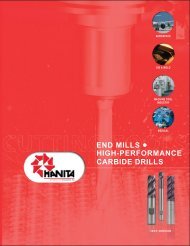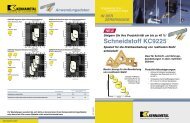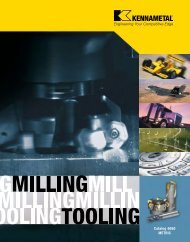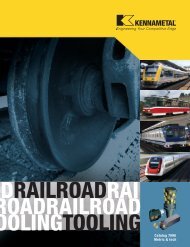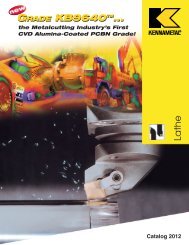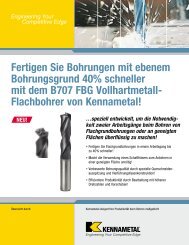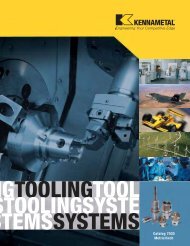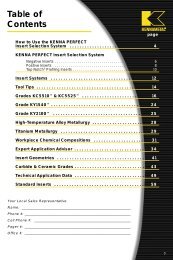NEWS 2005 - Jan Havelka
NEWS 2005 - Jan Havelka
NEWS 2005 - Jan Havelka
Create successful ePaper yourself
Turn your PDF publications into a flip-book with our unique Google optimized e-Paper software.
KM25 Tooling – Technical Information<br />
Application Data – Maximum Safe Operating Conditions<br />
HYDRAULIC CHUCKS<br />
COLLET CHUCKS/SLOTTING CUTTER ADAPTERS<br />
SHRINK FIT ADAPTERS<br />
TOOLING SYSTEMS<br />
VDI DRIVEN UNITS<br />
The KM25 Coupling<br />
The rigidity and stiffness of the patented KM25 joint<br />
is achieved through a combination of unique design<br />
elements incorporated in both the shank of the tool<br />
and the clamping mechanism. The KM25 joint was<br />
developed as a system and takes full advantage of<br />
both the tool shank and the mechanism to obtain<br />
maximum benefit from the space utilized.<br />
contact<br />
surfaces<br />
Taper Shank<br />
All KM25 tooling is designed around a short 10:1<br />
tapered shank. Extensive testing of many different<br />
lengths and angles proves this combination provides<br />
the maximum stiffness and input forces required for<br />
locking/unlocking. The taper is self-centering to<br />
promote easy tool loading and unloading.<br />
Face and Taper Contact<br />
KM25 tooling is designed to have simultaneous taper<br />
and face contact. Two alternate methods provide<br />
metal-to-metal contact. One method is to manufacture<br />
both halves of the coupling holding very close<br />
tolerances. The other is to design a small amount of<br />
elastic deformation into the assembly. With KM25<br />
tooling, elastic deformation takes the form of<br />
expansion of the female taper (on the clamping unit)<br />
as the larger male taper (on the cutting unit) is pulled<br />
back during lockup. Our testing proved that an<br />
optimum combination of pull-back force and elastic<br />
deformation (rather than a close tolerance) provides<br />
greater static and dynamic stiffness, achieves a metalto-metal<br />
fit, and is less costly to manufacture.<br />
Clamping Mechanism<br />
The mechanism design consists of two components; the<br />
torque screw, and the wedge nut. This simple, yet<br />
highly effective clamping mechanism allows the user to<br />
lock and unlock the cutting unit by simply using a<br />
preset torque wrench. This KM25 clamping mechanism<br />
fits inside the taper shank of the KM25 cutting unit and<br />
utilizes a coincidental cone design that maximizes the<br />
contact area between the clamping mechanism and the<br />
cutting unit. As a result, the cutting unit and clamping<br />
mechanism are on a shared axis and provide accurate<br />
axial and radial repeatability of ± .00008 inch<br />
(± 2 micron) for a specific cutting unit in a specific<br />
clamping unit. When more than one cutting unit is<br />
used, the accuracy of each cutting unit must be<br />
considered. Pre-gaging (when changing tools)<br />
measures the deviations of each tool from the nominal.<br />
These deviations can then be compensated for by the<br />
machine tool control offsets.<br />
Locking Sequence<br />
The clamping sequence starts with the insertion of the<br />
cutting unit into the female taper of the clamping unit.<br />
The cutting unit first makes contact at a stand-off from<br />
the gage face of approximately 0,25 mm (.010 inch).<br />
The torque screw is then activated by a preset torque<br />
wrench at a right angle to the centerline of the cutting<br />
tool, located behind the gage face of the clamping unit.<br />
A small amount of elastic deformation takes place at<br />
the front of the female taper as the locking force is<br />
applied. As the torque screw is further tightened to the<br />
preset torque of 25-30 ft-lbs. (34-40 Nm), (4-1/4 turns),<br />
the cutting unit advances until the gage face makes<br />
contact with the face of the clamping unit. The final<br />
amount of torque applied allows the tail of the cutting<br />
unit to spread to clamp securely between the clamping<br />
mechanism and the clamping unit inside diameter.<br />
Installation<br />
When initially clamping the KM25 shank in a machine<br />
tool slot, it is recommended that a cutting unit is in<br />
the shank.<br />
Lubrication<br />
Using a hex wrench, back out the torque screw against<br />
the positive stop and generously apply grease to the<br />
threads and conical surface of the component<br />
hardware. Also, apply grease to the female taper<br />
surface. This should be done periodically.<br />
Recommended grease: Gleitmo 805.<br />
KM25 QUICK-CHANGE SYSTEM<br />
C48<br />
Summary<br />
The KM25 coupling offers a very rigid joint with a high<br />
degree of repeatability while maintaining a very<br />
compact envelope. This permits a high degree of<br />
versatility without sacrificing cutting performance.<br />
For further technical information visit www.kennametal.com.



